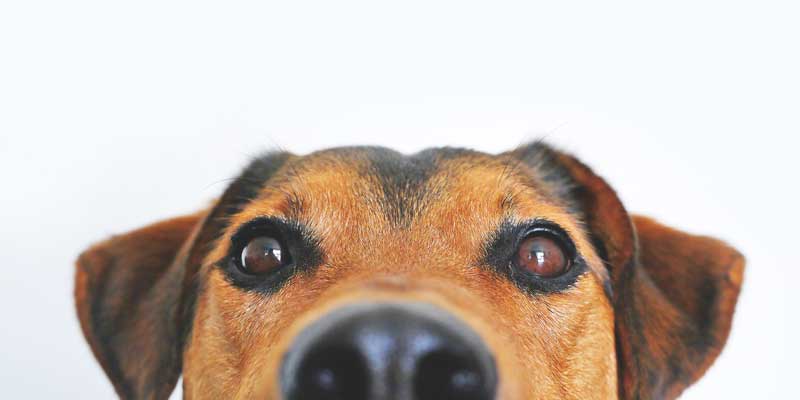
We all know that dogs can see some colors, but that’s about as far as most of us go. What about the details? Dogs’ visual systems are in many ways similar to ours, but they also have a few distinct differences and some fascinating quirks.
Best Selling Dog Treats
Last update on 2025-06-09 / Affiliate links / Images from Amazon Product Advertising API
Many dog breeds have the instinct like humans, such as herding livestock or hunting game. These breeds rely on keen eyesight to spot their prey and could do without the distraction of color vision.
Dogs might not appreciate all the colors like humans, but their world is not black or white. Let’s learn about how dogs see colors and more.
What Does a Dog’s Vision Look Like?
Dogs are dichromatic, and that’s why they are only limited to shades of gray, brown, yellow, and blue. Each type of cone detects a distinct wavelength of light. Humans like a crimson rose or a Granny Smith apple because of the one for color and green. Red-green cones are lacking in dogs and some color-blind people.
Most dogs are more sensitive to green light than humans, which is why many dog training collars use green light for correction. Most dogs have amber or brown eyes, and their peripheral vision is much greater than ours.
How Do Dogs See Colors?

There are just two different cones in a dog’s eye (just 20 percent of the cones in human eyes). As a result, a dog’s color palette is limited to grays, browns, blues, and yellows. This is known as dichromatic vision, and it is identical to red-green color blindness in people.
Some colors, such as red and orange tones, may seem to dogs as a different color, such as brown. Greens can take on a blue tint. Dogs may also have trouble distinguishing between shades of the same color, such as light blue and dark blue.
If your dog has trouble finding toys or rewards, keep this in mind. It’s not that he’s uninterested: it’s more probable that he can’t perceive what you’re trying to offer.
Try something blue or yellow the next time you’re shopping for dog toys to make your dog stand out more.
How Many Colors Does a Dog See?
One common misconception is that dogs can only see in black and white. The truth is that dogs have a full-color vision, but it’s not so much information to process.
The dog’s cone cells are concentrated on the retina’s center and are less sensitive to light than ours. That means they can’t see as many colors, but they can see a larger area.
Millions of rod-shaped cells provide vision in lower light at the back of the eye (retina).
Dogs’ eyes also have a membrane lining that reflects incoming light like a mirror — it’s called tapetum lucidum, which means “bright carpet.” It is located behind the retina, reflecting the incoming light to increase night vision.
Even though dogs can see color, their world is not full of colors. But they’re pretty good at recognizing what’s around them without much color information. They see best at a mid-range distance and are nearsighted. A visual sharpness is 50% less than a human’s during the daytime, so things may seem blurrier to them. However, they can still rely on their heightened sense of hearing and smell.
Can Dogs See in the Dark?

Yes, dogs can see in the dark, but they have difficulty seeing at night. They have a layer of light-sensitive tissue called “rods and cones,” which are much more sensitive to light than humans.
In most cases, dogs can see humans at night, but their vision is not as sharp or clear as ours. Night vision is an essential function of the rods and cones in the retina. Dogs with dark eyes might struggle to see clearly at night.
Can Dogs See White?
Dogs live in a world where white is present but only infrequently. They need to have a much broader palette of colors for dogs to see the world as we do. Dogs can see a range of brightnesses and shades, but white is one of their main challenges.
Red, orange and yellow are likely the colors dogs see most often. Blue skies and objects also fall into this category. White takes longer to distinguish, and dogs with brown eyes see it as black.
Color Blindness in Dogs

Many dogs with red-green color blindness are not considered to be “discriminated” against. Their owners do not know it, and even the veterinarian might be unable to tell. In order for their owners to know about this condition, subtle signs are needed by the owner.
The most obvious sign is coat color
Red-green color blindness in dogs can be distinguished from a black or white dog simply by examining the coat. Those dogs with brown or amber eyes usually have more difficulty showing their actual coat color.
Dogs can be classified into three types of “color blindness” based on the nature of their vision:
- Normal: A dog with normal color vision can see in yellow, green, and orange shades. Dogs who are not red-green colorblind can distinguish between yellow and black objects. They also respond to red and blue hues better than green ones.
- Deuteranopia: Dogs with this color blindness can see yellow, orange, and red best. The rest of the colors fall into green or black categories.
- Protanopia: A dog may be protanopic when he cannot see any color at all, but only shades of gray and brown. This condition is genetic and passes from generation to generation in particular dogs.
Most dogs have normal color vision and cannot see red, orange, and yellow very well. They can tell the difference between black and white objects, but they may not distinguish shades of gray or brown.
The first step in correcting the problem is determining whether this is a color blindness problem by taking the dog’s coat to the vet. If it is determined that it isn’t an eye disorder, then talk to your veterinarian about an available color vision test.
Signs Your Dog Needs an Eye Exam

The best way to determine whether your dog needs an eye exam is to watch him play. For example, when he chases a ball or frisbee, he must detect it visually (not with his nose).
When you engage in a game of fetch with your dog, you should notice that the ball slows down his movement so that he can track it better. If your dog always seems to have trouble tracking objects and playing fetch, it could be a sign that he needs an eye exam.
It is possible to have a normal eye exam with subnormal vision, so if you suspect your dog has something wrong with his eyes, you should still take him in.
As much as 85% of all dogs are born with impaired vision and often do not know the difference. These dogs see varying degrees of blackness or redness. In some cases, the reduced vision may be mild (fuzzy); in others, it may be severe enough to cause problems for the dog.
The first step in correcting the problem is determining whether this is a color blindness problem by taking your dog to a veterinarian and examining his eyes. If it is determined that it isn’t an eye disorder, then talk to your veterinarian about an available color vision test.
Final thoughts
Dogs are unique creatures. Their eyes can see, but that doesn’t necessarily mean their vision is the same as ours. Animals depend on their senses and instincts to survive and lead happy life.
The next time you’re with your dog, sit back and admire how he sees the world!








I love this blog!